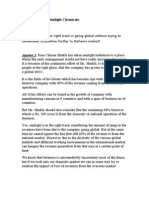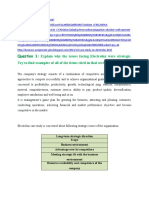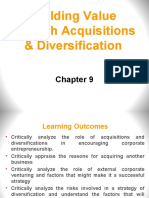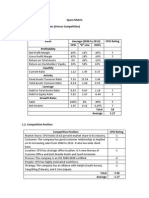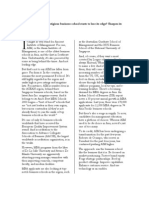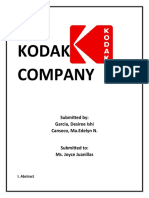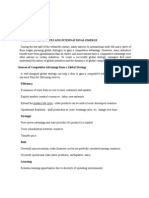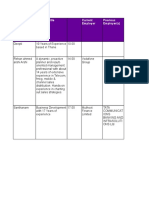Electrolux Case Answers To Questions
Electrolux Case Answers To Questions
Uploaded by
blackjack00Copyright:
Available Formats
Electrolux Case Answers To Questions
Electrolux Case Answers To Questions
Uploaded by
blackjack00Original Title
Copyright
Available Formats
Share this document
Did you find this document useful?
Is this content inappropriate?
Copyright:
Available Formats
Electrolux Case Answers To Questions
Electrolux Case Answers To Questions
Uploaded by
blackjack00Copyright:
Available Formats
CHAPTER 1-------Introducing strategy
Case example------Electrolux
This is an introductory case example to illustrate the various elements of strategy – as presented
in Chapter 1. It shows how these apply to a particular industry and competitors within the
industry. These are some of the issues to highlight:
Are these issues strategic?
Section 1.1 of the chapter lists various characteristics of strategic decisions. You can ‘apply’
this list to the case example. For example, they do affect:
Long-term direction
Competitive advantage
Scope of activities
Exploitation of core competences
Stakeholder expectations.
Levels of strategy
There are several levels of strategy at Electrolux:
Corporate (company as a whole)
Business Line (e.g. ‘Consumer Durables’)
Business Units (e.g. ‘White Goods Europe’)
Operational (departments within business units).
The Strategic position
Some of the main issues are as follows:
Environment
Globalised industry
Competitive mature markets
Power of major retailers
Market entry of Asian producers (LG, Samsung) via contracts with major retailers
Also, developing markets (Eastern Europe, China)
Changing consumer needs (polarisation in the market)
Consolidation of retail outlets.
Capability
Originally, industrial design
Cost efficiency
Geographical coverage
Consumer insights
Brands
Talent management.
Expectations
The need to maintain profitability – which has not proved easy in a very competitive
industry
Environmental issues (e.g. CFCs and recycling).
Strategic choices
We can think about the various ‘strands’ that make up a strategic choice as
outlined in section 1.3.2 (and, of course, more fully in Chapters 6–9):
The market is polarising, so there are two possible bases to gain competitive advantage.
Either position 1 on the strategy clock (the low price ‘commodity’ positioning) or
differentiated (‘value-added’ product/service features) positions 4 and 5 on the clock. It is
not easy to run these two different positioning in parallel – without clever use of brands.
There are several choices of development direction for Electrolux. Decisions on product
development usually concern new features built on the current ‘platform’. Otherwise costs
are difficult to contain. Market development opportunities exist in developing countries
alongside the ‘trading-up’ of consumer requirements as economies become more prosperous.
The method of development is also important. Electrolux’s recent history has been dominated
by acquisitions.
Strategy into action
These aspects of strategy into action are illustrated in Electrolux:
The company has had to restructure regularly as it grew. Acquisitions also required pruning
and disposals to prevent the company from losing focus. The most recent decision to demerge
the ‘outdoor products’ division as a separate company (Husqvarna) reflects a feeling
in many sectors that re-focusing on a core business and core markets is likely to be more
successful than a wider portfolio of activities. Point out to students that this is absolutely the
opposite as to what happened at Electrolux in the 1970s and 1980s where, amongst other
things, they had extended into metal manufacture.
There is not much information about detailed processes, except reference to better product
renewal and improvements in logistics, purchasing and production
Managing change would be a particularly important issue given the possibility of cultural
clash in such a geographically spread organisation. Also, development by acquisitions
increases the cultural difficulties.
You might also like
- International Certificate in Wealth and Investment Management Ed6Document468 pagesInternational Certificate in Wealth and Investment Management Ed6Annabella Petro100% (2)
- Strategy Electrolux Case Study All Answers PDFDocument11 pagesStrategy Electrolux Case Study All Answers PDFaditya kumar100% (3)
- CASE STUDY - Sunlight ChemicalsDocument4 pagesCASE STUDY - Sunlight ChemicalsCoulibaly Younous80% (5)
- Operations Management in Automotive Industries: From Industrial Strategies to Production Resources Management, Through the Industrialization Process and Supply Chain to Pursue Value CreationFrom EverandOperations Management in Automotive Industries: From Industrial Strategies to Production Resources Management, Through the Industrialization Process and Supply Chain to Pursue Value CreationNo ratings yet
- Electrolux Sample Question and AnswerDocument24 pagesElectrolux Sample Question and AnswerKyaw Kyaw100% (1)
- Assignment Marketing 1 Adv-diplma-AnsellDocument10 pagesAssignment Marketing 1 Adv-diplma-AnsellNitesh Benzankar100% (1)
- The Impact of Inflation On Working CapitalDocument16 pagesThe Impact of Inflation On Working CapitalVishal Mohanka0% (1)
- Global Dimensions of ManagementDocument25 pagesGlobal Dimensions of ManagementncostalNo ratings yet
- Samsung Electronics Innovation and Design StrategyDocument10 pagesSamsung Electronics Innovation and Design StrategyMuyly Nene100% (1)
- Investment in Equity Securities - SeatworkDocument2 pagesInvestment in Equity Securities - SeatworkLester ColladosNo ratings yet
- Business Plan On Garment ShopDocument28 pagesBusiness Plan On Garment Shopjyotidevi09100% (3)
- ElectroluxDocument6 pagesElectroluxumartariqNo ratings yet
- 1 Electrolux CaseDocument3 pages1 Electrolux CaseAndreea Conoro0% (1)
- Strategy ElectroluxDocument48 pagesStrategy Electroluxsarsagarwal100% (1)
- Case Study - ElectroluxDocument5 pagesCase Study - ElectroluxEmranul Islam Shovon67% (3)
- Electrolux Case StudyDocument10 pagesElectrolux Case StudyNandar Swe Tint67% (3)
- Case #4. WestinghouseDocument4 pagesCase #4. WestinghouseDarkest Dark100% (2)
- ElectroluxDocument3 pagesElectroluxRupeet Singh100% (1)
- ElectroluxDocument2 pagesElectroluxpoongaNo ratings yet
- Written Report - ElectroluxDocument10 pagesWritten Report - ElectroluxIrina Nicoleta Scarlat100% (1)
- International BusinessDocument19 pagesInternational BusinessSagar Yadav100% (1)
- Electrolux Assignment On Strategic ManagementDocument24 pagesElectrolux Assignment On Strategic Managementabankwan85% (13)
- 1Document21 pages1Joshua S MjinjaNo ratings yet
- Benefit From Export CompetitivenessDocument7 pagesBenefit From Export CompetitivenessDarkest DarkNo ratings yet
- Electrolux Fact Sheet Corporate StrategyDocument3 pagesElectrolux Fact Sheet Corporate StrategyYuvraj JaipalNo ratings yet
- Read The Following Case Study Carefully and Answer The Questions Given at The End: Case # 3. ElectroluxDocument3 pagesRead The Following Case Study Carefully and Answer The Questions Given at The End: Case # 3. ElectroluxDarkest DarkNo ratings yet
- Assignment PM The Case 1Document3 pagesAssignment PM The Case 1Ali Khan88% (8)
- Raw Material SeekerDocument15 pagesRaw Material SeekerNurbayah SubohNo ratings yet
- Chapter 9 - Building Value Through Acquisitions - DiversificationDocument16 pagesChapter 9 - Building Value Through Acquisitions - DiversificationNabil MustaqimNo ratings yet
- Space Matrix SampleDocument3 pagesSpace Matrix SampleAngelicaBernardoNo ratings yet
- ElectroluxDocument2 pagesElectroluxAlexandra Popa67% (3)
- Case 3Document6 pagesCase 3danica4444No ratings yet
- AssignmentDocument13 pagesAssignmentRoy Kachale BandaNo ratings yet
- Asian Institute of ManagementDocument7 pagesAsian Institute of ManagementheinzteinNo ratings yet
- Intrapreneurship 150520060758 Lva1 App6891Document21 pagesIntrapreneurship 150520060758 Lva1 App6891Arti BhatiNo ratings yet
- Factors Affecting Deposit MobilizationDocument13 pagesFactors Affecting Deposit MobilizationVu Minh ChauNo ratings yet
- Kodak Company: Submitted By: Garcia, Desiree Ishi Canseco, Ma - Edelyn NDocument6 pagesKodak Company: Submitted By: Garcia, Desiree Ishi Canseco, Ma - Edelyn NMared CansecoNo ratings yet
- Global Market Entry Strategies and Internationalization ProcessDocument25 pagesGlobal Market Entry Strategies and Internationalization ProcessPrasad GantiNo ratings yet
- Andrew - Lambert@kcl - Ac.uk: Department of War Studies, King's College LondonDocument11 pagesAndrew - Lambert@kcl - Ac.uk: Department of War Studies, King's College LondonVitus van RijNo ratings yet
- Porters DiamondDocument30 pagesPorters DiamondKuthubudeen T MNo ratings yet
- Whirlpool Management StrategyDocument5 pagesWhirlpool Management StrategynimrawadoodNo ratings yet
- Kasus Bab 6 - Loblaw Companies LimitedDocument3 pagesKasus Bab 6 - Loblaw Companies LimitedYan_Chii0% (1)
- BCG MatrixDocument34 pagesBCG MatrixSaurabGhimireNo ratings yet
- Model Question For International Business, 2 Semester Masters in Business StudiesDocument2 pagesModel Question For International Business, 2 Semester Masters in Business StudiesDevkota SunilNo ratings yet
- Introduction To Operations Management: True / False QuestionsDocument19 pagesIntroduction To Operations Management: True / False Questionsgenc221100% (1)
- Management 595 - Fall 2019 Exam 1 Study Guide: A. Essay QuestionsDocument8 pagesManagement 595 - Fall 2019 Exam 1 Study Guide: A. Essay QuestionsmeghanNo ratings yet
- Tme 601Document14 pagesTme 601dearsaswatNo ratings yet
- Debate On Marketing ManagementDocument3 pagesDebate On Marketing ManagementTang Zhen HaoNo ratings yet
- Capital StructureDocument41 pagesCapital Structure/jncjdncjdnNo ratings yet
- Strategic ManagementDocument26 pagesStrategic ManagementJulian DurangoNo ratings yet
- Agree and Disagree Statements StrategyDocument2 pagesAgree and Disagree Statements Strategyapi-248208787No ratings yet
- Company Electronics Appliances Semiconductors South Korea's: SamsungDocument61 pagesCompany Electronics Appliances Semiconductors South Korea's: Samsunghaseeb ahmedNo ratings yet
- Renault Nissan Strategic AllianceDocument15 pagesRenault Nissan Strategic AllianceMridul Dohutia100% (2)
- Ikea EssayDocument10 pagesIkea Essaymeray8No ratings yet
- Business Strategy Mid Term Short AnswersDocument4 pagesBusiness Strategy Mid Term Short AnswersMonil ChhedaNo ratings yet
- ch2 PDFDocument24 pagesch2 PDFVignesh RajaramNo ratings yet
- SamsungDocument7 pagesSamsungTedo Imanto100% (1)
- Strategy Analysis Assignment - M2Document12 pagesStrategy Analysis Assignment - M2Aravind KayampadyNo ratings yet
- The Effect of Globalisation On A Hotels Marketing StrategyDocument10 pagesThe Effect of Globalisation On A Hotels Marketing StrategyAslam Abdullah MarufNo ratings yet
- Unit 6Document16 pagesUnit 6YonasNo ratings yet
- Traditional Motives and International EmergeDocument7 pagesTraditional Motives and International Emergesujoy12345No ratings yet
- Obligations To Achieving Strategic FitDocument8 pagesObligations To Achieving Strategic FitADARSH RAGESHNo ratings yet
- Analysis of Corporate Strategy of AB Electrolux - EditedDocument7 pagesAnalysis of Corporate Strategy of AB Electrolux - EditedDaniel Otieno100% (1)
- Isb Cdo BrochureDocument25 pagesIsb Cdo Brochureroseland1976No ratings yet
- 1 - GMR in MaldivesDocument2 pages1 - GMR in Maldivesrajthakre81No ratings yet
- Debt Deception: How Debt Buyers Abuse The Legal System To Prey On Lower-Income New Yorkers (2010)Document36 pagesDebt Deception: How Debt Buyers Abuse The Legal System To Prey On Lower-Income New Yorkers (2010)Jillian Sheridan100% (1)
- Newsbriefs 20110107Document3 pagesNewsbriefs 20110107Maien VitalNo ratings yet
- Time Value of Money PDF Notes - Download HereDocument7 pagesTime Value of Money PDF Notes - Download HereUnni KuttanNo ratings yet
- ObaidDocument1 pageObaidgopal.lalwaniNo ratings yet
- IMG SSBYF Partial PDFDocument46 pagesIMG SSBYF Partial PDFJohn Carl DeninaNo ratings yet
- GSTReturn Oct 2021Document1 pageGSTReturn Oct 2021Muhammad Ali Abdul RazzaqueNo ratings yet
- Project Report ON Elasticity of Demand & Supply: Mba/Pgdm (2009-2011) New Delhi Institute of ManagementDocument32 pagesProject Report ON Elasticity of Demand & Supply: Mba/Pgdm (2009-2011) New Delhi Institute of ManagementNitin Rana75% (8)
- SWM-CE6 - Detailed Report On Legal Aspects of E-Waste - Management Rule 2016Document12 pagesSWM-CE6 - Detailed Report On Legal Aspects of E-Waste - Management Rule 2016Mansi RupneNo ratings yet
- Financial Activities of Rastriya Banijya Bank Limited: An Internship ReportDocument45 pagesFinancial Activities of Rastriya Banijya Bank Limited: An Internship ReportPrajwol Thapa100% (1)
- Fedex Ratesheets: Proposal No.: 9819742 1 / 11Document11 pagesFedex Ratesheets: Proposal No.: 9819742 1 / 11nanananacmonNo ratings yet
- Ross12e Chapter04 TBDocument25 pagesRoss12e Chapter04 TBHải YếnNo ratings yet
- Analisis Metode Kanban Dan Metode Junbiki Pada Persediaan Part Muffler Di Pt. XyzDocument18 pagesAnalisis Metode Kanban Dan Metode Junbiki Pada Persediaan Part Muffler Di Pt. XyzAnjar GustaramNo ratings yet
- L1 and L2 SlidesDocument74 pagesL1 and L2 SlidesRupal AgarwalNo ratings yet
- Sample Resume - CV - Arch2011 - Kevindeysenroth - Working Professional - BestDocument3 pagesSample Resume - CV - Arch2011 - Kevindeysenroth - Working Professional - BestSachin TichkuleNo ratings yet
- Kroll Ratings SolarDocument8 pagesKroll Ratings SolareddiecNo ratings yet
- Manufacturing Resource Planning: Presented by MT14IND001 Industrial EngineeringDocument28 pagesManufacturing Resource Planning: Presented by MT14IND001 Industrial Engineeringanam kaziNo ratings yet
- Fiscal PolicyDocument90 pagesFiscal PolicyDutta SubhajitNo ratings yet
- Syrma SGS Tech LTD IPO Research Note 1Document7 pagesSyrma SGS Tech LTD IPO Research Note 1Saurabh SinghNo ratings yet
- BBA-V 551 Subjective Dec 2016Document2 pagesBBA-V 551 Subjective Dec 2016Saif ali KhanNo ratings yet
- Appraisal of Lease InterestsDocument55 pagesAppraisal of Lease InterestsLuningning CariosNo ratings yet
- ICEP CSS - PMS Presentation-by-Dr-Ishrat-Husain Pakistan Macro Economy - Current Situation and Way ForwardDocument43 pagesICEP CSS - PMS Presentation-by-Dr-Ishrat-Husain Pakistan Macro Economy - Current Situation and Way ForwardNadeem SheikhNo ratings yet
- Final Question Bank With Answers - Treasury Management-Final ExamDocument7 pagesFinal Question Bank With Answers - Treasury Management-Final ExamHarsh MaheshwariNo ratings yet
- UadyyDocument33 pagesUadyyVishal ParasharNo ratings yet
- Compras - ProveedoresDocument158 pagesCompras - ProveedorestristhanNo ratings yet
- Saketh Narendula CVDocument1 pageSaketh Narendula CVLalit YadavNo ratings yet


